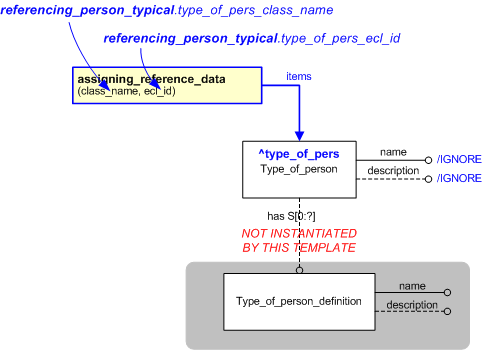| Template:— referencing_person_typical (ref_pers_typ) |
Date: 2008/03/05 21:18:03
Revision: 1.4
|
This section specifies the template referencing_person_typical.
NOTE
An explanation of a template and the associated instantiation path is
provided in the
Template overview
section.
This template describes how to reference a type of person by its class name.
NOTE
The Type_of_person_definition
has been omitted from this template.
The EXPRESS-G diagram in
Figure
1
shows the templates and EXPRESS entities that are required
to represent the template
"referencing_person_typical".
The text highlighted in blue shows the template parameters.
Figure 1 — An EXPRESS-G representation of the Information model for referencing_person_typical
The graphic for the template to be used in other EXPRESS-G diagrams
is shown in Figure
2
below.
Figure 2 — The graphical representation of the referencing_person_typical template
The following input parameters are defined for this template:
The name of the
External_class that determines the type of person being referenced.
The following classes and their sub-classes can be used:
The following reference parameters are defined for this template:
Allow the
Type_of_person
entity instantiated in this path to be referenced when this template is used.
Note: The
Type_of_person
entity can be referenced in a template path by:
%^target = $referencing_person_typical.type_of_pers%
The following parameter combinations specify a uniqueness constraint:
Unique constraint: Type of person
The instantiation path shown below specifies the entities that are to be
instantiated by the template.
The following entities are instantiated with attributes as specified:
The instance diagram in Figure
3
shows an example of the EXPRESS entities and templates that are instantiated by the template:
/referencing_person_typical(type_of_pers_class_name='Welder', type_of_pers_ecl_id='urn:plcs:rdl:sample')/
(an illustration of the consolidated referencing_person_typical template is shown in
Figure
4 below.)
Figure 3 — Entities instantiated by referencing_person_typical template
The instance model in STEP ASCII exchange file format (ISO 10303 Part
21 syntax) is:
#1 = TYPE_OF_PERSON('/IGNORE','/IGNORE',());
#3 = CLASSIFICATION_ASSIGNMENT(#4,(#1),'/IGNORE');
#5 = EXTERNAL_CLASS('/NULL','Welder','/IGNORE',#6);
#6 = EXTERNAL_CLASS_LIBRARY('urn:plcs:rdl:sample',$);
The instance model in STEP XML exchange file format (ISO 10303 Part
28 ed.2 syntax) is:
The instance diagram in
Figure
4
shows the graphic symbol for the template that is to be
used in other instance diagrams. The example template is:
/referencing_person_typical(type_of_pers_class_name='Welder', type_of_pers_ecl_id='urn:plcs:rdl:sample')/
Figure 4 — Instantiation of referencing_person_typical template
The following section details how the
referencing_person_typical
template can be optionally characterized by assigning
other constructs to it. These are characterizations commonly
applied to the template. The ISO 10303-239 EXPRESS model may enable
other assignments to the entities instantiated by the template.
The following characterizations may apply:
Characterization Assigning descriptor
NOTE this characterization is optional.




